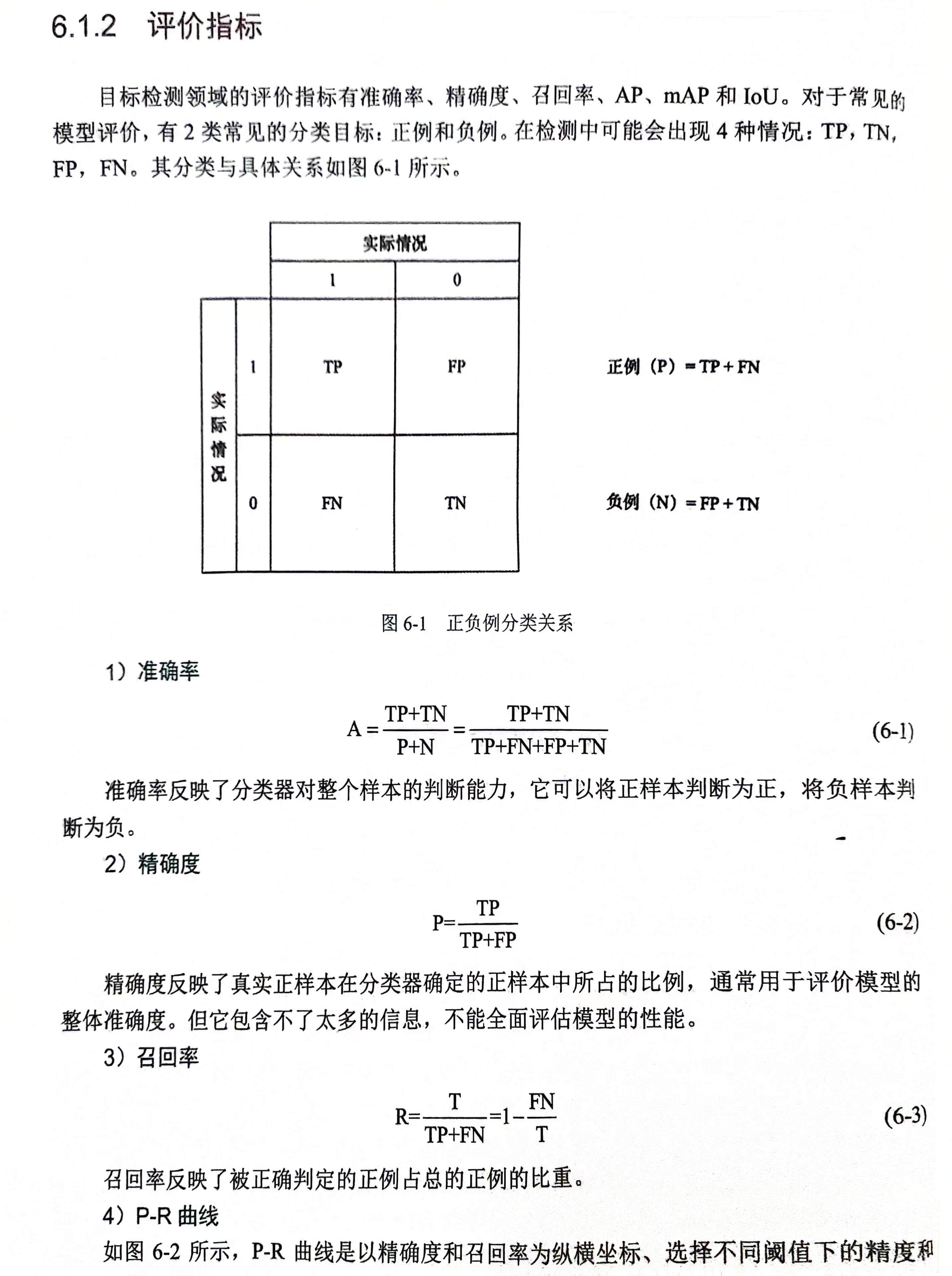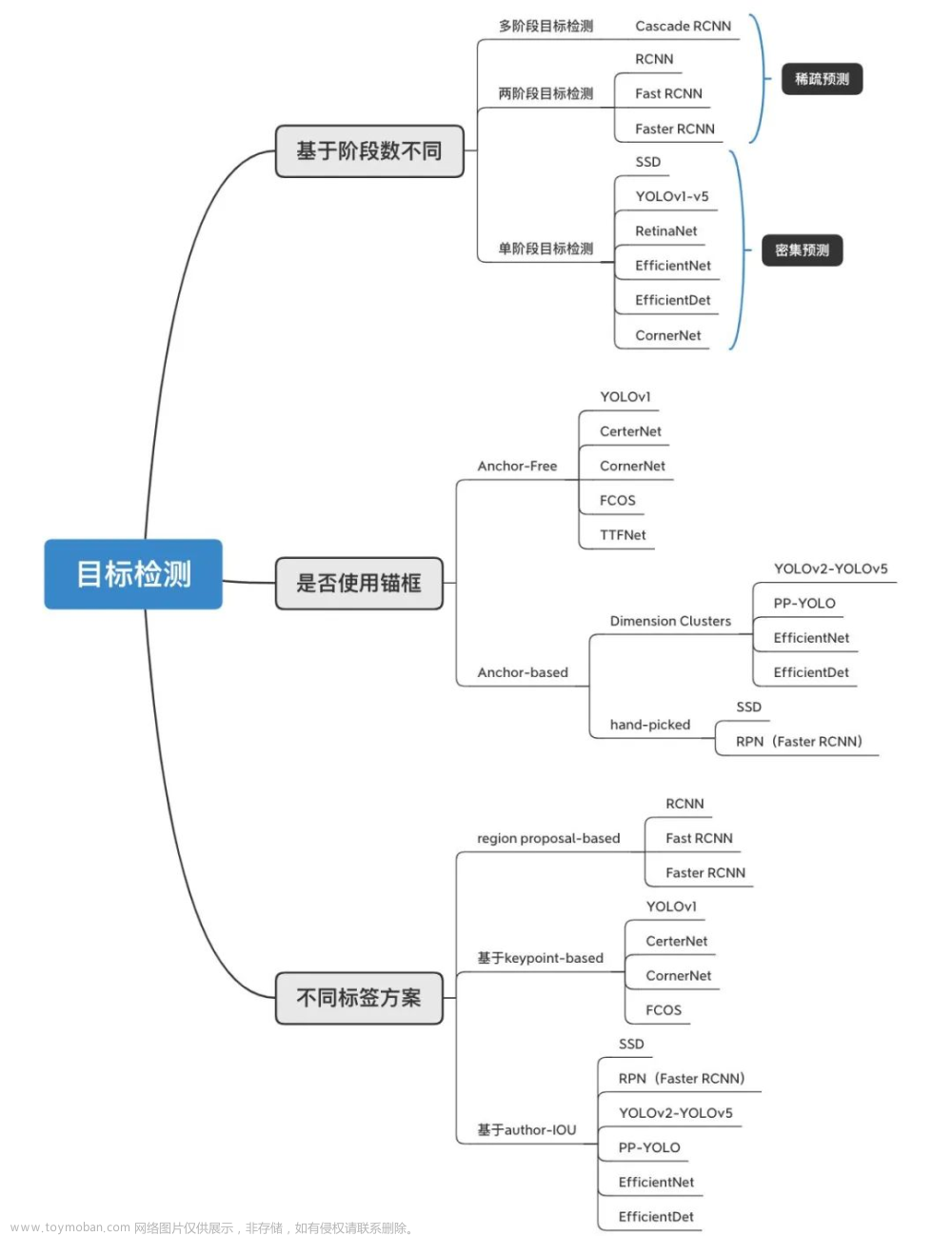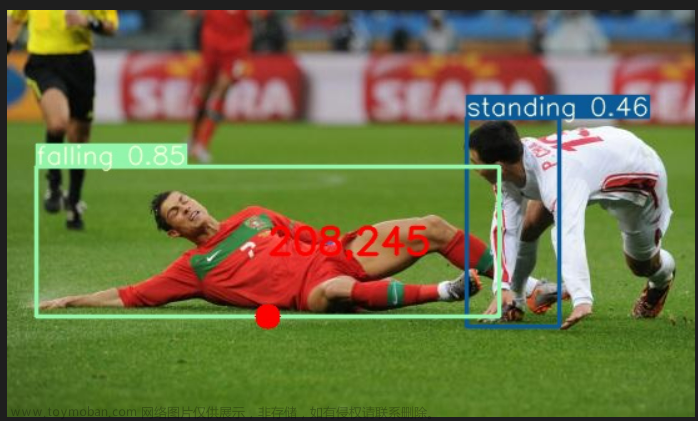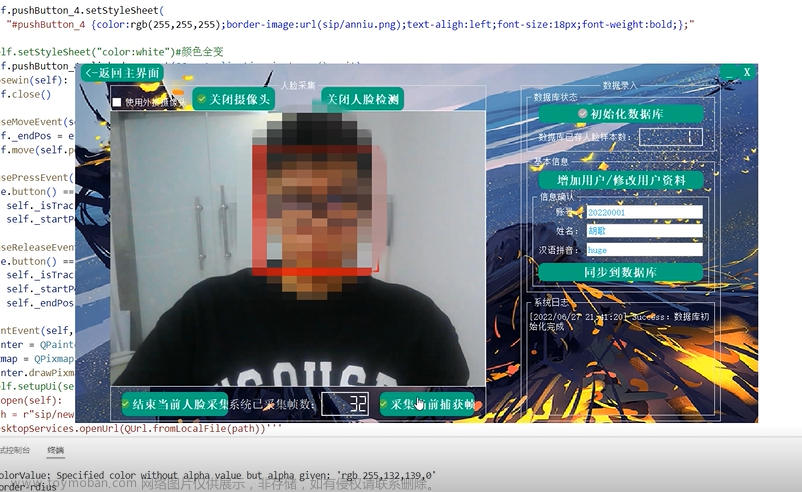前言
本文讲解使用halcon的目标检测是使用步骤,标注工具不使用halcon提供的标注工具,而是使用各个深度学习框架都使用的labelImg工具,然后使用hde脚本以及python脚本转化为标准的halcon训练及文件
本文涉及数据标注、数据转化、训练、评估、预测几个模块。
一、数据集的准备
首先我是用的是halcon数据集里边的药片,去了前边的100张做标注,后面的300张做测试,其中100张里边选择90张做训练集,10张做验证集。
1.标注工具的安装
pip install labelimg
进入cmd,输入labelimg,会出现如图的标注工具:
2.数据集的准备
首先我们先创建3个文件夹,如图:
DataImage:100张需要标注的图像
DataLabel:空文件夹,主要是存放标注文件,这个在labelimg中生成标注文件
test:存放剩下的300张图片,不需要标注
DataImage目录下和test目录的存放样子是这样的(以DataImage为例):
3.标注数据
首先我们需要在labelimg中设置图像路径和标签存放路径,如图:
然后先记住快捷键:w:开始编辑,a:上一张,d:下一张。这个工具只需要这三个快捷键即可完成工作。
开始标注工作,首先按下键盘w,这个时候进入编辑框框的模式,然后在图像上绘制框框,输入标签(框框属于什么类别),即可完成物体1的标注,一张物体可以多个标注和多个类别,但是切记不可摸棱两可,比如这张图像对于某物体标注了,另一张图像如果出现同样的就需要标注,或者标签类别不可多个,比如这个图象A物体标注为A标签,下张图的A物体标出成了B标签,最终的效果如图:
最后标注完成会在DataLabel中看到标注文件,json格式:
4.解释xml文件的内容

xml标签文件如图,我们用到的就只有object对象,对其进行解析即可。
二、数据转换
数据转换分为两步,首先使用python脚本解析xml文件,然后使用hdev脚本实现halcon训练所需要的训练文件
1.解析XML文件
此处解析xml,提取每张图像的目标类别及位置
with open(xmlfile, "r", encoding="utf-8") as in_file:
tree = ET.parse(in_file)
root = tree.getroot()
for obj in root.iter('object'):
cls = obj.find('name').text
if cls not in classes:
classes.append(cls)
cls_id = classes.index(cls)
xmlbox = obj.find('bndbox')
b = (int(xmlbox.find('xmin').text),int(xmlbox.find('ymin').text), int(xmlbox.find('xmax').text),int(xmlbox.find('ymax').text))
list_file += " " + ",".join([str(a) for a in b]) + ',' + str(cls_id)
if cls not in label_name_dict:
label_name_dict[cls]=0
label_name_dict[cls]+=1
TrainDataList.append(list_file)
with open(os.path.join(SaveDir,'classes.txt'), encoding="utf-8", mode="w") as f:
for each in range(len(classes)):
f.write(classes[each] + "\n")
with open(os.path.join(SaveDir,'TrainList.txt'), encoding="utf-8", mode="w") as f:
for each in TrainDataList:
f.write(each + "\n")
最
后得到的效果主要是两个txt文件:
‘TrainList.txt’:训练数据
‘classes.txt’:类别数据
如图:

2.转换得到hdev文件
1.变量定义
* 前边生成的类别文件
class_txt:='../DataSet/Temp_DetDataSet/classes.txt'
* 前边生成的数据标注文件
train_txt:='../DataSet/Temp_DetDataSet/TrainList.txt'
* 基于halcon转化脚本下的图像保存路径
ImageDir:='../DataSet/DataImage'
* 基于halcon训练脚本下的图像保存路径
BaseImgDir:='./DataSet/DataImage'
* 保存为halcon识别的训练文件
dict_File:='../DataSet/Temp_DetDataSet/dl_dataset.hdict'
2.读取种类
open_file (class_txt, 'input', FileHandle)
repeat
fread_line(FileHandle, oneline, IsEOF)
if(IsEOF == 1)
break
endif
if(oneline == ' ' or oneline=='\n')
continue
endif
tuple_regexp_replace (oneline, '\n', '', oneline)
tuple_length (ClassID, Length)
ClassID[Length]:=Length+1
tuple_concat (ClassName, oneline, ClassName)
until (IsEOF)
3.解析trainList.txt
TrainDataList:=[]
open_file (train_txt, 'input', FileHandle)
repeat
fread_line(FileHandle, oneline, IsEOF)
if(IsEOF == 1)
break
endif
if(oneline == ' ' or oneline=='\n')
continue
endif
tuple_regexp_replace (oneline, '\n', '', oneline)
tuple_concat (TrainDataList, oneline, TrainDataList)
until (IsEOF)
4.生成字典
for Index := 0 to |TrainDataList|-1 by 1
EachTrainList:=TrainDataList[Index]
tuple_split (EachTrainList, ' ', DataList)
imageFile:=DataList[0]
tuple_length (DataList, Length)
DataList:=DataList[1:Length-1]
create_dict (SampleImage)
set_dict_tuple (SampleImage, 'image_id', Index+1)
set_dict_tuple (SampleImage, 'image_file_name', imageFile)
bbox_label_id:=[]
bbox_row1:=[]
bbox_col1:=[]
bbox_row2:=[]
bbox_col2:=[]
for bbox_index:=0 to |DataList|-1 by 1
bbox_data:=DataList[bbox_index]
tuple_split (bbox_data, ',', bbox_data_list)
tuple_number (bbox_data_list[4], Number)
tuple_concat (bbox_label_id, Number+1, bbox_label_id)
tuple_number (bbox_data_list[1], Number)
tuple_concat (bbox_row1, Number, bbox_row1)
tuple_number (bbox_data_list[0], Number)
tuple_concat (bbox_col1, Number, bbox_col1)
tuple_number (bbox_data_list[3], Number)
tuple_concat (bbox_row2, Number, bbox_row2)
tuple_number (bbox_data_list[2], Number)
tuple_concat (bbox_col2, Number, bbox_col2)
endfor
set_dict_tuple (SampleImage, 'bbox_label_id', bbox_label_id)
set_dict_tuple (SampleImage, 'bbox_row1', bbox_row1)
set_dict_tuple (SampleImage, 'bbox_col1', bbox_col1)
set_dict_tuple (SampleImage, 'bbox_row2', bbox_row2)
set_dict_tuple (SampleImage, 'bbox_col2', bbox_col2)
tuple_concat (AllSamples, SampleImage, AllSamples)
endfor
最后得到的字典结构如图所示:

三、模型训练
1.参数定义
* 主干网络结构
Base_ModelFile := ['pretrained_dl_classifier_compact.hdl','pretrained_dl_classifier_enhanced.hdl','pretrained_dl_classifier_resnet50.hdl']
* 先验框的设置
MinLevel := 2
MaxLevel := 4
NumSubscales := 3
AspectRatios := [1.0,0.5,2.0]
Capacity := 'medium'
* 显示预训练数据效果
showExample:=true
* 模型选择
ModelType := 1
* 输入网络结构的图像大小及通道
ImageWidth := 416
ImageHeight := 416
ImageNumChannels := 3
*上边脚本生成的训练文件
TrainDict:='./DataSet/Temp_DetDataSet/dl_dataset.hdict'
* 原图路径
ImgDir:='./DataSet/DataImage'
* 训练时生成的临时文件都放入此文件夹内
OutPutDir:='./DataSet/Temp_DetDataSet/Output'
DataDirectory := OutPutDir + '/dldataset_pill_bag_' + ImageWidth + 'x' + ImageHeight
* 保存最后训练模型以及效果最好模型
BestModelBaseName := OutPutDir + '/best_dl_model_detection'
FinalModelBaseName := OutPutDir + '/final_dl_model_detection'
DLDatasetFileName := DataDirectory + '/dl_dataset.hdict'
* 自定义保存最后的模型
ModelFile:='./best_Det.dat'
* 保存数据预处理的模型参数
ModelParams:='./det_params.hdict'
* 每次迭代的图片量
batch_size := 2
* 学习率
learning_rate := 0.001
* 优化器
Momentum := 0.9
* 迭代次数
NumEpochs := 600
2.创建目标检测模型
create_dict (DLModelDetectionParam)
set_dict_tuple (DLModelDetectionParam, 'image_width', ImageWidth)
set_dict_tuple (DLModelDetectionParam, 'image_height', ImageHeight)
set_dict_tuple (DLModelDetectionParam, 'image_num_channels', ImageNumChannels)
set_dict_tuple (DLModelDetectionParam, 'min_level', MinLevel)
set_dict_tuple (DLModelDetectionParam, 'max_level', MaxLevel)
set_dict_tuple (DLModelDetectionParam, 'num_subscales', NumSubscales)
set_dict_tuple (DLModelDetectionParam, 'aspect_ratios', AspectRatios)
set_dict_tuple (DLModelDetectionParam, 'capacity', Capacity)
create_dl_model_detection (Base_ModelFile[ModelType], NumClasses, DLModelDetectionParam, DLModelHandle)
set_dl_model_param (DLModelHandle, 'class_ids', class_ids)
3.数据预处理
TrainingPercent := 85
ValidationPercent := 15
SeedRand := 42
set_system ('seed_rand', SeedRand)
split_dl_dataset (DictHandle, TrainingPercent, ValidationPercent, [])
create_dl_preprocess_param_from_model (DLModelHandle, 'false', 'full_domain', [], [], [], DLPreprocessParam)
4.显示标注文件
dev_display_dl_data (DLSampleBatchDisplay[Index], [], DictHandle, 'bbox_ground_truth', GenParam, WindowHandleDict)
get_dict_tuple (WindowHandleDict, 'bbox_ground_truth', WindowHandles)
* 显示信息
dev_set_window (WindowHandles[0])
get_dict_object (Image, DLSampleBatchDisplay[Index], 'image')
get_image_size (Image, ImageWidth, ImageHeight)
dev_disp_text ('New image size after preprocessing: ' + ImageWidth + ' x ' + ImageHeight, 'window', 'bottom', 'right', 'black', [], [])
dev_set_window (WindowHandles[1])
dev_disp_text ('Press Run (F5) to continue', 'window', 'bottom', 'right', 'black', [], [])
5.模型训练
1.学习率设置
ChangeLearningRateEpochs :=[]
ChangeLearningRateValues :=[]
IndexNum:=0
for Index:=1 to 600 by 50
ChangeLearningRateEpochs[IndexNum] :=50*(IndexNum+1)
* 现在学习率 = 上一次学习率*0.5 每ChangeLearningRateEpochs次修改一次学习率
tuple_pow (0.9, (IndexNum+1), Pow)
ChangeLearningRateValues[IndexNum]:=learning_rate*Pow
IndexNum :=IndexNum + 1
endfor
2.初始化训练模型
read_dict (DLDatasetFileName, [], [], DLDataset)
set_dl_model_param (DLModelHandle, 'learning_rate', learning_rate)
set_dl_model_param (DLModelHandle, 'momentum', Momentum)
set_dl_model_param (DLModelHandle, 'batch_size', batch_size)
if (|WeightPrior| > 0)
set_dl_model_param (DLModelHandle, 'weight_prior', WeightPrior)
endif
set_dl_model_param (DLModelHandle, 'runtime_init', 'immediately')
3.模型训练
create_dl_train_param (DLModelHandle, NumEpochs, EvaluationIntervalEpochs, DisplayEvaluation, SeedRandom, GenParamName, GenParamValue, TrainParam)
train_dl_model (DLDataset, DLModelHandle, TrainParam, 0.0, TrainResults, TrainInfos, EvaluationInfos)
训练过程如图:
四、模型评估
1.初始化模型
read_dict (DLDatasetFileName, [], [], DLDataset)
set_dl_model_param (DLModelHandle, 'learning_rate', learning_rate)
set_dl_model_param (DLModelHandle, 'momentum', Momentum)
set_dl_model_param (DLModelHandle, 'batch_size', batch_size)
if (|WeightPrior| > 0)
set_dl_model_param (DLModelHandle, 'weight_prior', WeightPrior)
endif
set_dl_model_param (DLModelHandle, 'runtime_init', 'immediately')
2.创建模型及训练模型
create_dl_train_param (DLModelHandle, NumEpochs, EvaluationIntervalEpochs, DisplayEvaluation, SeedRandom, GenParamName, GenParamValue, TrainParam)
train_dl_model (DLDataset, DLModelHandle, TrainParam, 0.0, TrainResults, TrainInfos, EvaluationInfos)
训练模型过程如图:
四、模型评估及验证
for Index := 0 to 5 by 1
read_dl_samples (DLDataset, DLSampleIndicesShuffled[Index], DLSampleBatch)
apply_dl_model (DLModelHandle, DLSampleBatch, [], DLResultBatch)
dev_display_dl_data (DLSampleBatch, DLResultBatch, DLDataset, 'bbox_both', GenParam, WindowHandleDict)
dev_disp_text ('Press Run (F5) to continue', 'window', 'bottom', 'right', 'black', [], [])
stop ()
endfor
效果如图:



五、模型预测
1.载入模型
open_file (ModelFile, 'input_binary', FileHandle)
fread_serialized_item (FileHandle, SerializedItemHandle)
close_file (FileHandle)
deserialize_dl_model (SerializedItemHandle, DLModelHandle)
read_dict (TrainDict, [], [], DictHandle)
get_dict_tuple (DictHandle, 'class_ids', class_ids)
get_dict_tuple (DictHandle, 'class_names', class_names)
2.载入预测
read_image (ImageBatch, ImageFiles[Index1])
gen_dl_samples_from_images (ImageBatch, DLSampleBatch)
preprocess_dl_samples (DLSampleBatch, DLPreprocessParam)
apply_dl_model (DLModelHandle, DLSampleBatch, [], DLResultBatch)
效果如图:
 文章来源:https://www.toymoban.com/news/detail-696011.html
文章来源:https://www.toymoban.com/news/detail-696011.html
总结
无文章来源地址https://www.toymoban.com/news/detail-696011.html
到了这里,关于halcon脚本-深度学习【目标检测】的文章就介绍完了。如果您还想了解更多内容,请在右上角搜索TOY模板网以前的文章或继续浏览下面的相关文章,希望大家以后多多支持TOY模板网!













